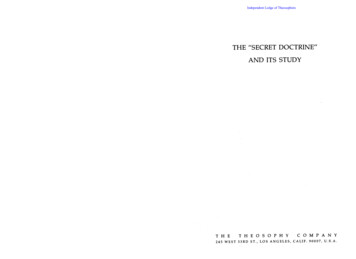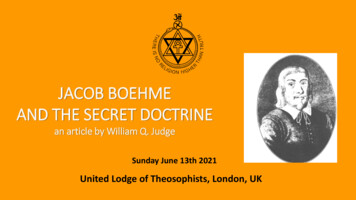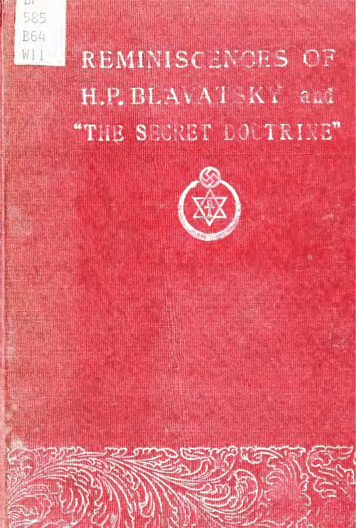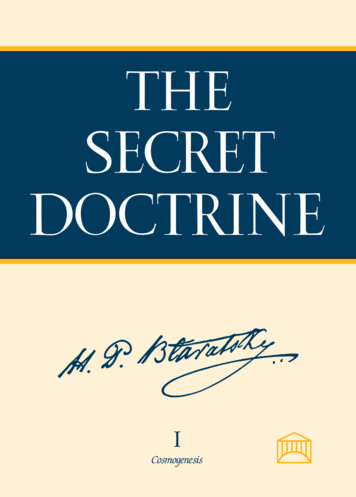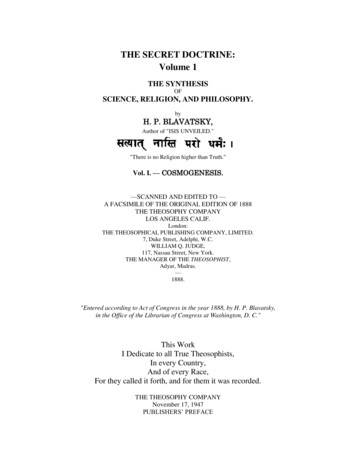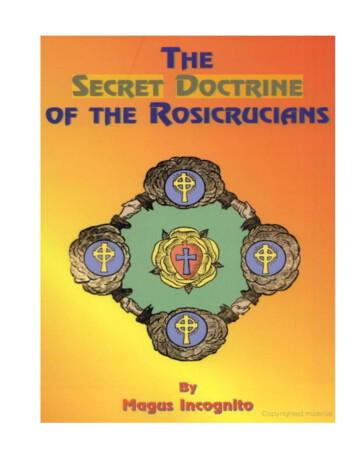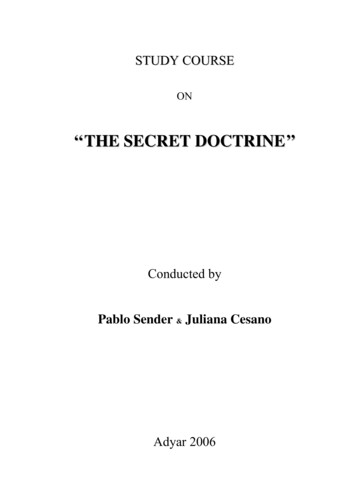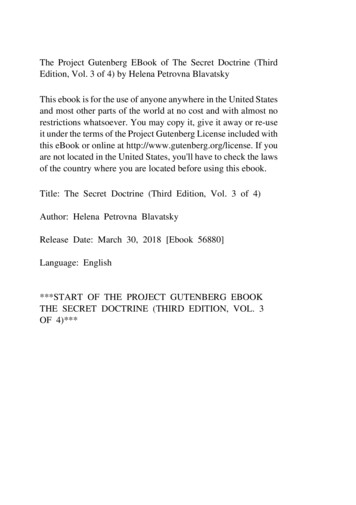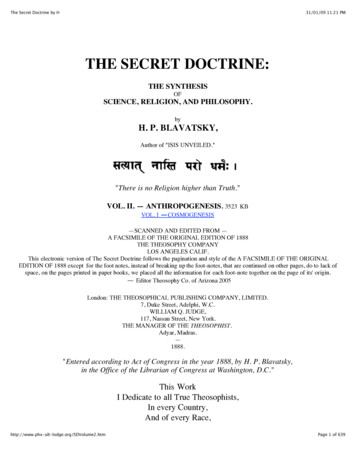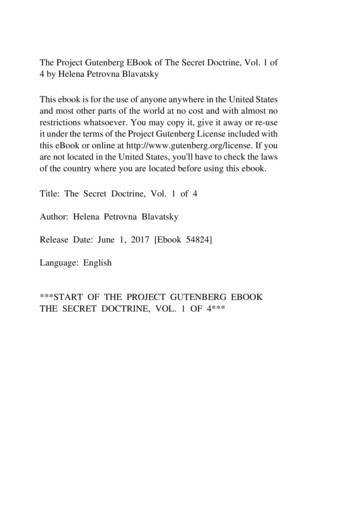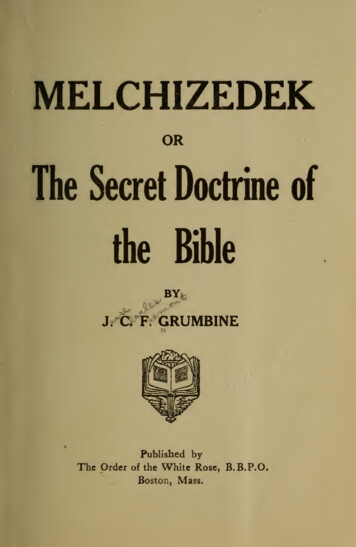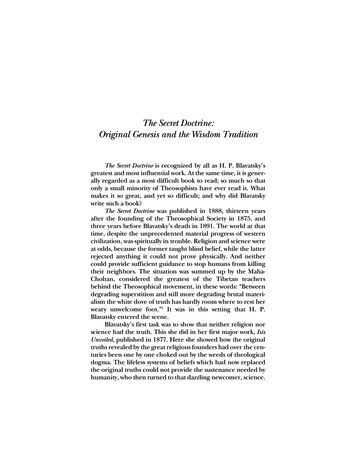
Transcription
The Secret Doctrine:Original Genesis and the Wisdom TraditionThe Secret Doctrine is recognized by all as H. P. Blavatsky’sgreatest and most influential work. At the same time, it is generally regarded as a most difficult book to read; so much so thatonly a small minority of Theosophists have ever read it. Whatmakes it so great, and yet so difficult; and why did Blavatskywrite such a book?The Secret Doctrine was published in 1888, thirteen yearsafter the founding of the Theosophical Society in 1875, andthree years before Blavatsky’s death in 1891. The world at thattime, despite the unprecedented material progress of westerncivilization, was spiritually in trouble. Religion and science wereat odds, because the former taught blind belief, while the latterrejected anything it could not prove physically. And neithercould provide sufficient guidance to stop humans from killingtheir neighbors. The situation was summed up by the MahaChohan, considered the greatest of the Tibetan teachersbehind the Theosophical movement, in these words: “Betweendegrading superstition and still more degrading brutal materialism the white dove of truth has hardly room where to rest herweary unwelcome foot.”1 It was in this setting that H. P.Blavatsky entered the scene.Blavatsky’s first task was to show that neither religion norscience had the truth. This she did in her first major work, IsisUnveiled, published in 1877. Here she showed how the originaltruths revealed by the great religious founders had over the centuries been one by one choked out by the weeds of theologicaldogma. The lifeless systems of beliefs which had now replacedthe original truths could not provide the sustenance needed byhumanity, who then turned to that dazzling newcomer, science.
2The Secret Doctrine:But science, said Blavatsky, however impressive, could notprovide what humanity needed either, because it was confinedto physical reality only, with no concern for morality or virtue.It was quite oblivious to the higher realities which alone givedignity and purpose to human life.Blavatsky in Isis Unveiled not only showed that neitherreligion nor science had the truth, she also showed that somewhere it could yet be found. This caused much excitement. Shebrought out for the first time to the modern world the fact ofthe existence of an ancient and once universal but now hiddenbody of truths which she called the Wisdom Religion. She saidthat this once universal Wisdom Religion was the source fromwhich all the world’s religions sprang; but over time, asseparativism and materialism progressed, each came to believethat its piece was the only truth. Traditions found all around theworld speak of this as leaving the Golden Age and entering theIron Age or Dark Age. Blavatsky marshalled an impressive massof evidence from ancient writers across the globe, swelling thetwo large volumes of Isis Unveiled, to show the former existenceof a Wisdom Tradition. The higher truths universally recognized by the ancients had disappeared from religion, and werebeyond the ken of science; but humanity once had them. Suchwas the message of Isis Unveiled.Isis Unveiled thus prepared the ground for the restorationof many truths from the Wisdom Tradition, that for long ageswere lost to the world. Although some of these had already beenbrought out in Isis Unveiled, the bulk of them were yet to come.Further, Isis Unveiled was something of an experiment, and wasnot received as well as may have been expected. This wasbecause, as stated by the Mahatma K.H., a book like thisemanating from a woman, and also one who many believed tobe a Spiritualist, “could never hope for a serious hearing.”2Thus it fell to a respectable English newspaper editor, A. P.Sinnett, to attempt the first account of teachings from theWisdom Tradition which would be taken seriously.Sinnett was a polished writer, while Blavatsky barely knewEnglish when she wrote Isis Unveiled, so that she regarded it asher most poorly written book.3 Sinnett had begun a correspon-
Original Genesis and the Wisdom Tradition3dence with Blavatsky’s teachers, the Mahatmas K.H. and M., in1880.4 His first book, The Occult World, published in 1881,showed the probability of the existence of human individualswho had perfected their spiritual development. These theTheosophists called Mahatmas. But it was his second book,Esoteric Buddhism, published in 1883, that contained the firstsystematic account of those truths from the Wisdom Traditionnow allowed by these Mahatmas to come out. Based on thematerial in their letters, he constructed a coherent approximation of their system. These teachings, known to the modernworld as Theosophy, provided such satisfying answers to thegreat problems of life that even critics were impressed. A criticalnewspaper article of the time had to call them “marvelous,even in this day of scientific research,” going on to say: “EsotericBuddhism itself is enough to set the intellectual world in commotion. It is the most philosophical method of explaining life,death and eternity yet made known, even whether we like it ornot.”5 Yet it set only a small part of the intellectual world incommotion, and that only for a time. Thus even this effortproved to be not enough. So, back to the drawing board, or inthis case, the writing table. Now Blavatsky resuscitated a projectbegun already in 1879,6 which was to become her greatest work,The Secret Doctrine.The Secret Doctrine is based on stanzas which Blavatskytranslated from a secret “Book of Dzyan.” These stanzas coverthe genesis of the cosmos and the genesis of humanity. This isthe core of the book. The Secret Doctrine also includes extensivematerial on symbolism, saying that this was the language universally used by the ancients, and that therefore all ancient writingsmust be understood in this light, and not taken literally. Finally,The Secret Doctrine includes much material on science, continuing to show, as she did earlier, that there exist occult forces innature which remain unrecognized by science. Thus The SecretDoctrine does not treat, except incidentally, the general systemwhich has come to be known as Theosophy, including karma,reincarnation, the seven principles of a human being, the sevenplanes of the cosmos, the after-death states, etc., as was outlined earlier in Esoteric Buddhism, and would be treated later in
4The Secret Doctrine:Blavatsky’s The Key to Theosophy. Why is this? Why the genesissubject matter and not the more familiar Theosophical teachings in the greatest Theosophical work?The Secret Doctrine is referred to by Blavatsky as “this first instalment of the esoteric doctrines.”7 For the first time we have materialtranslated directly from an original source book of the WisdomTradition. Isis Unveiled had made known the existence of theWisdom Tradition, but in comparison with her new book, hadunveiled practically nothing of it. Esoteric Buddhism was basedon the more or less fragmentary information received in lettersfrom the Mahatmas, so it did not give the actual esoteric systemas such.8 Here, for the first time, we have the real thing, at leastthe first instalment of it. Knowing this, we are now in a positionto understand the reason for the genesis subject matter.In explaining what is in The Secret Doctrine, Blavatsky says:“Nor could the vast catalogue of the Archaic Sciences beattempted in the present volumes, before we have disposed ofsuch tremendous problems as Cosmic and Planetary Evolution,and the gradual development of the mysterious Humanitiesand races that preceded our ‘Adamic’ Humanity.”9 This is onlylogical, taking first things first; but I believe that there is more toit than appears on the surface. Blavatsky’s teachers were facedwith the same problem the Dalai Lama now faces in bringingout hitherto secret material. A good example of this is theKålacakra Tantra. The Tibetan Buddhist Tantras, or Books ofKiu-te, were traditionally kept secret. However, the first chapterof the Kålacakra Tantra is on cosmology, including cosmogonyor genesis. Because of its subject matter, this is the only chapterwhich could be openly discussed. Thus books based on thischapter and its subject matter circulated openly in Tibet, whilematerial from the remaining four chapters was restricted. This,I believe, is the true reason for the choice of genesis as thesubject matter of the stanzas translated in The Secret Doctrine.It was the only choice possible for the first instalment of theesoteric doctrines to be brought out directly from hithertosecret original sources.Nonetheless, it was a quite an excellent choice. Thegenesis teachings of The Secret Doctrine, covering the origin and
Original Genesis and the Wisdom Tradition5development of the cosmos, and the origin and development ofhumanity, are unparalleled by any other such teachings foundanywhere. No system is more comprehensive and self-consistentthan that of The Secret Doctrine. No, nothing else even comesclose. The greatest genesis accounts of the world are feeble incomparison. As put by the Gnostic scholar, G. R. S. Mead, in1904, “The Stanzas set forth a cosmogenesis and anthropogenesis which, in their sweep and detail, leave far behind anyexisting record of such things from the past.” He further saysthat, “I advisedly call these passages, enshrined in her works,marvellous literary creations, not from the point of view of anenthusiast who knows nothing of Oriental literature, or thegreat cosmogonical systems of the past, or the Theosophy of theWorld Faiths, but as the mature judgment of one who has beenfor some twenty years studying just such subjects.”10 I can echothese words precisely, and can now add to the list of suchsubjects studied, the many Sanskrit works which have becomeavailable in the nearly one hundred years since he wrote this.What is considered to be the oldest genesis account foundin the East is the brief so-called “Creation Hymn” of the RigVeda.11 Similar accounts are found in the Upanishads, based onthe Vedas.12 A more detailed account is found in the next mostauthoritative source, the Laws of Manu.13 Much more elaborateaccounts are then found in the various Puranas,14 which haveremained the basis of most cosmogonic ideas found in HinduIndia until modern times. All of these were available in translation both during the time of Blavatsky and the time of Mead.But the important Buddhist cosmological sources had not yetbeen published, nor had the Jaina sources.The authoritative Jaina compendium, TattvårthådhigamaSütra, whose third chapter is on cosmology, was first publishedin Sanskrit from 1903 to 1905, in German in 1906, and in English in 1920.15 Further details could be found in Kundakunda’sPa cåstikåyasåra, or “The Building of the Cosmos,” published inPrakrit, Sanskrit, and English in 1920.16 The Buddhist sourcesproved to be more difficult, because the original Buddhisttradition in India had been lost. Recognizing the importance ofVasubandhu’s fundamental source work, the Abhidharmako a,
6The Secret Doctrine:the leading Buddhist scholars of Europe jointly agreed on aplan to translate it from its Chinese and Tibetan versions. Thistask was finally accomplished by the great Belgian scholar,Louis de La Vallée Poussin, who published a French translationin six volumes from 1923 to 1931.17 Its Sanskrit original was notdiscovered until Rahula Sankrityayana’s trips to Tibet in searchof Sanskrit manuscripts in the 1930s, and was then published in1947, with its Sanskrit auto-commentary following in 1967.18Much more recently, the Kålacakra texts have become available,providing an alternative cosmology to the traditional Buddhistcosmology described in chapter three of the Abhidharmako a. Ihave edited in Sanskrit and translated into English some of thisnew material for a paper comparing it with the “Book of Dzyan,”presented at the first Secret Doctrine Symposium in 1984.19All this material is indeed interesting, but like the previousHindu texts, none of these Jaina or Buddhist texts provedto contain anything close to the comprehensiveness of thecosmogonic account in The Secret Doctrine. For example, theAbhidharmako a speaks of the four modes of birth, following thewords of the Buddha, as the sweat-born, the egg-born, thewomb-born, and the parentless, just as The Secret Doctrine does.20But the detailed accounts of the earlier humanities in whichthese modes of birth took place, found in The Secret Doctrine, areabsent in the now existing teachings of Buddhism. ThusVasubandhu in his auto-commentary, and Ya omitra in his subcommentary, had to scramble to find explanations for thesestrange ideas. Since the Buddha had spoken of them, they mustbe true, and now needed to be explained. So the commentatorscame up with examples from mythology, of stories of individualhumans that could be considered to have been egg-born andsweat-born; e.g., aila and Upa aila were born from the eggs of acrane, and Åmrapålî was born from the stem of a banana tree.21For the parentless, however, they gave the example of thehumanity of the first age, or kalpa, in agreement with TheSecret Doctrine.22 Here a fragment of the Wisdom Tradition wasapparently preserved.Thus while the general outlines of genesis have beenpreserved in existing works, and even some details as in the case
Original Genesis and the Wisdom Tradition7of the Buddha’s references to the four modes of birth, thecommentaries which once existed and which alone can providethe true explanations, says Blavatsky, are no longer to be found:“An immense, incalculable number of MSS., and even printedworks known to have existed, are now to be found no more. They havedisappeared without leaving the slightest trace behind them.Were they works of no importance they might, in the naturalcourse of time, have been left to perish, and their very nameswould have been obliterated from human memory. But it is notso; for, as now ascertained, most of them contained the truekeys to works still extant, and entirely incomprehensible, for thegreater portion of their readers, without those additional volumesof Commentaries and explanations.”23But these works are not lost, and the esoteric schoolswhich Blavatsky’s teachers are associated with claim to havethem all.24 It is from these works that Blavatsky restored tohumanity nothing less than the original, full and uncut versionof genesis. The point of all this was to let the world know thatsomewhere the true answers to the great problems of life exist.Because as stated by the Maha-Chohan, from the 1881 letterquoted earlier,25To be true, religion and philosophy must offer thesolution of every problem. That the world is in such a badcondition morally is a conclusive evidence that none of itsreligions and philosophies, those of the civilised races lessthan any other, have ever possessed the truth. The rightand logical explanations on the subject of the problems ofthe great dual principles—right and wrong, good and evil,liberty and despotism, pain and pleasure, egotism andaltruism—are as impossible to them now as they were 1881years ago. They are as far from the solution as they everwere but,—To these there must be somewhere a consistent solution,and if our doctrines will show their competence to offer it,then the world will be the first one to confess that must bethe true philosophy, the true religion, the true light, whichgives truth and nothing but the truth.
8The Secret Doctrine:Blavatsky in The Secret Doctrine brought out to the worldthe original teachings on genesis from the Wisdom Tradition,offering a consistent solution to the great problems of cosmicand planetary evolution. Now the world could see for itself thecompetence of these doctrines to provide the truth. Yet theworld has not confessed that this must be the truth. No, in morethan a century, the world has not even given them a hearing.This was not entirely unanticipated. Blavatsky wrote in the“Introductory” to The Secret Doctrine that, “Agreeably with therules of critical scholarship, the Orientalist has to reject a prioriwhatever evidence he cannot fully verify for himself. . . . Therefore, the rejection of these teachings may be expected, andmust be accepted beforehand. No one styling himself a‘scholar,’ in whatever department of exact science, will be permitted to regard these teachings seriously.”26 This has referenceto “the most serious objection to the correctness and reliabilityof the whole work,”27 namely, the fact that no one has seen the“Book of Dzyan” from which the Stanzas in The Secret Doctrinewere translated. The proof which would be provided by anoriginal manuscript of one of its Sanskrit, Tibetan, or Chineseversions28 was not possible in 1888. This is made quite clear inthe first sentence of the first Mahatma letter, written in 1880:“Precisely because the test of the London newspaper wouldclose the mouths of the skeptics—it is unthinkable.”29 ButBlavatsky goes on to say about the teachings of The Secret Doctrinein the “Introductory” just quoted, “They will be derided andrejected a priori in this century; but only in this one. For in thetwentieth century of our era scholars will begin to recognizethat the Secret Doctrine has neither been invented nor exaggerated, but, on the contrary, simply outlined; and finally, thatits teachings antedate the Vedas.”30Thus I believe that the influence of Blavatsky’s greatestwork, The Secret Doctrine, though written more than a hundredyears ago, has barely begun to be felt; and that only when anoriginal manuscript of the “Book of Dzyan” is brought out,which may now be possible, will it take its proper place in theworld. Then only will Blavatsky’s efforts in laying the foundation for the re-establishment in the world of the truths of the
Original Genesis and the Wisdom Tradition9Wisdom Tradition be vindicated. Blavatsky would undoubtedlycare little for any personal vindication, but for the vindicationof the teachings of The Secret Doctrine, which she believed wereof the utmost benefit to humanity, she would certainly caregreatly.Notes1. Combined Chronology, by Margaret Conger, Pasadena: Theosophical University Press, 1973, p. 44; The Mahatma Letters to A. P.Sinnett, compiled by A. T. Barker, arranged in chronological sequenceby Vicente Hao Chin, Jr., Quezon City, Metro Manila, Philippines:Theosophical Publishing House, 1993, p. 478.2. The Mahatma Letters to A. P. Sinnett, 2nd ed., London: Rider &Co., 1926, p. 50; 3rd ed., revised by Christmas Humphreys and ElsieBenjamin, Adyar, Madras: Theosophical Publishing House, 1962,p. 50; chronological ed., 1993, p. 67.3. See: “My Books,” in H. P. Blavatsky Collected Writings, vol. XIII,Wheaton, Illinois: Theosophical Publishing House, 1982, pp. 191-202;especially pp. 191-92: “Of all the books I have put my name to,this particular one is, in literary arrangement, the worst and mostconfused.”4. This correspondence was published as The Mahatma Letters toA. P. Sinnett, first edition in 1923, and subsequent editions as given innotes 1 and 2 above. The original letters are now held in the BritishMuseum.5. From: “Our Theosophists,” The Daily Examiner, San Francisco,July 1, 1888, quoted in The Dawning of the Theosophical Movement, byMichael Gomes, Wheaton, Illinois: Theosophical Publishing House,1987, p. 150.6. See: Boris de Zirkoff’s “Historical Introduction: How ‘TheSecret Doctrine’ Was Written,” in the H. P. Blavatsky Collected Writingsedition of The Secret Doctrine, Adyar, Madras, Theosophical PublishingHouse, 1978, pp. [1-2], where he quotes Col. H. S. Olcott’s Old DiaryLeaves, series II, p. 90, on this.7. The Secret Doctrine, vol. I, p. xxxvii.8. Indeed, the Mahatma K.H., writing in 1884, refers to “the real
10The Secret Doctrine:vital errors in Esoteric Buddhism,” and goes on to say that, “The SecretDoctrine will explain many things, set to right more than one perplexedstudent.” See: The Mahatma Letters to A. P. Sinnett, 2nd ed., p. 357; 3rded., p. 351; chron. ed., p. 428. Two sections of The Secret Doctrine are infact devoted to correcting these early Theosophical misconceptions.See: The Secret Doctrine, vol. I, pp. 152-191.9. The Secret Doctrine, vol. I, p. xlii.10. “Concerning H.P.B. (Stray Thoughts on Theosophy),” byG. R. S. Mead, Adyar Pamphlets, no. 111, Adyar, Madras: TheosophicalPublishing House, 1920, p. 16; reprinted from The Theosophical Review,vol. XXXIV, April 1904, pp. 130-144.11. Rig Veda 10.129. Most of this hymn in Max Müller’s translation is given on p. 26 of vol. I of The Secret Doctrine, facing the openingof the seven stanzas on cosmic evolution translated from the Book ofDzyan. A few other hymns from the Rig Veda can also be consideredcosmogonic, including the well-known “Hymn to the Cosmic Person,”10.90, and hymns 10.72, 10.81, 10.82, and 10.121.12. See, for example, the Aitareya Upanishad, which begins:“The self, verily, was (all) this, one only, in the beginning.” (S.Radhakrishnan translation.) Blavatsky had referred to this in an earlydraft of the three fundamental propositions of The Secret Doctrine, in asentence not found in the published book, regarding the first proposition: “In the Aitareya Upanishad this Principle is referred to as the SELF,the only one—as just shown.” See the facsimile reproduction of thispage in Boris de Zirkoff’s “Historical Introduction,” cited in note 6above, p. [36].13. The Laws of Manu, a book of law, provides a genesis accountin its first chapter. Compare The Secret Doctrine, vol. I, p. 333, regardingthis chapter: “But there is, directly following these verses, somethingmore important for us, as it corroborates entirely our esoteric teachings. From verse 14 to 36, evolution is given in the order described inthe Esoteric philosophy. This cannot be easily gainsaid.”14. Among the eighteen major puråñas, the Vißñu Puråña isoften thought to be the most representative of the traditional fivefoldsubject matter of a puråña, including genesis. H. H. Wilson’s translation of the Vishñu Puråña, which also includes extensive annotationsfrom the other puråñas, was much quoted by Blavatsky in The SecretDoctrine.
Original Genesis and the Wisdom Tradition1115. Sanskrit edition: Tattvårthådhigama by Umåsvåti, ed. ModyKeshavlal Premchand, Calcutta: Asiatic Society of Bengal, 1903-1905,Bibliotheca Indica 159; German translation: “Eine Jaina-Dogmatik.Umåsvåti’s Tattvårthådhigama Sütra,” trans. Hermann Jacobi,Zeitschrift der Deutschen Morganländischen Gesellschaft, vol. 60, 1906,pp. 287-325, 512-551; English translation: Tattvarthadhigama Sutra(A Treatise on the Essential Principles of Jainism), trans. J. L. Jaini, Arrah:Central Jaina Publishing House, 1920, Bibliotheca Jainica, SacredBooks of the Jainas 2. Two more English translations have since beenpublished in India, and now one in the West: That Which Is—Tattvårtha Sütra, trans. Nathmal Tatia, San Francisco: HarperCollinsPublishers, 1994.16. The Building of the Cosmos, or Pa chåstikåyasåra (the Five CosmicConstituents), ed. and trans. A. Chakravartinayanar, Arrah: CentralJaina Publishing House, 1920, Bibliotheca Jainica, Sacred Books ofthe Jainas 3.17. L’Abhidharmako a de Vasubandhu, trans. Louis de la ValléePoussin, 6 vols., Paris: Paul Geuthner, 1923-1931, Société Belged’Études Orientales. Poussin’s French translation has now been translated into English by Leo M. Pruden as Abhidharmako abhåßyam,4 vols., Berkeley: Asian Humanities Press, 1988-1990. Poussin hadpreviously published separately its third chapter, on cosmology, in hisBouddhisme: Études et Matériaux—Cosmologie, 1919.18. The Abhidharmako a was first edited in Sanskrit by V. V.Gokhale, and published in Journal of the Bombay Branch of the Royal Asiatic Society, new series, vol. 22, 1946, pp. 73-102, with an emendation invol. 23, 1947, p. 12. Its auto-commentary, or Abhidharmako abhåßyam,was edited in Sanskrit by P. Pradhan, Patna: K. P. Jayaswal ResearchInstitute, 1967, Tibetan Sanskrit Works Series 8, with a second revisededition in 1975.19. “New Light on the Book of Dzyan,” by David Reigle, inSymposium on H. P. Blavatsky’s Secret Doctrine: Proceedings, San Diego:Wizards Bookshelf, 1984, pp. 54-67. [See above, pp. 25-41.] Since thena book surveying the Abhidharma and the Kålacakra cosmologies,and also the Mahåyåna cosmology of the Flower Ornament Scripture(Avataµsaka Sütra) and other sütras, as well as the Dzog-chen cosmology, has been published: Myriad Worlds: Buddhist Cosmology inAbhidharma, Kålacakra, and Dzog-chen, by Jamgön Kongtrul Lodrö
12The Secret Doctrine:Tayé, Ithaca, New York: Snow Lion Publications, 1995. The Mahåyånacosmology had earlier been described, drawing on the Mahåpraj åpåramitå åstra, the Lotus Sütra (Saddharma-puñ arîka Sütra), andthe Pure Land or Sukhåvatî-vyüha Sütra, in comparison with theAbhidharma cosmology, in Buddhist Cosmology, by Randy Kloetzli,Delhi: Motilal Banarsidass, 1983. The Mahåyåna cosmology has againbeen described, from the Flower Garland Sütra (Avataµsaka Sütra)and the Sukhåvatî-vyüha Sütra, in comparison with the Abhidharmacosmology, in Buddhist Cosmology, by Akira Sadakata, Tokyo: KøseiPublishing Co., 1997.20. Abhidharmako a and bhåßyam, 3.8-9.21. Abhidharmako abhåßyam and vyåkhyå on 3.9.22. Abhidharmako abhåßyam 3.9: “upapådukå puna pråthamakalpikå .”23. The Secret Doctrine, vol. I, p. xxv. Similarly, half of the contentsof the Upanishads are said by Blavatsky to have been eliminated, sothat, “They CONTAIN the beginning and the end of all human knowledge, butthey have now ceased to REVEAL it, since the day of Buddha.”—The SecretDoctrine, vol. I, p. 270.24. “The members of several esoteric schools—the seat of whichis beyond the Himålayas, and whose ramifications may be found inChina, Japan, India, Tibet, and even in Syria, besides South America—claim to have in their possession the sum total of sacred andphilosophical works in MSS. and type: . . .” The Secret Doctrine, vol. I,p. xxiii.25. Combined Chronology, p. 47; The Mahatma Letters to A. P. Sinnett,chron. ed., p. 480.26. The Secret Doctrine, vol. I, p. xxxvii.27. The Secret Doctrine, vol. I, p. xxii.28. Sanskrit, Tibetan, and Chinese glosses on the Book of Dzyanare referred to in The Secret Doctrine, vol. I, p. 23, and in a letterby Blavatsky, quoted in Boris de Zirkoff’s “Historical Introduction,”p. [29].29. The Mahatma Letters to A. P. Sinnett, all eds., p. 1. This hasreference to a test proposed by Sinnett, to produce one day’s editionof the London Times in Simla, India, on the same day it came out inLondon. London and Simla were at least a month apart by communication other than telegraph in 1880. This would prove that the
Original Genesis and the Wisdom Tradition13phenomena produced by Blavatsky were genuine, and therefore thather Mahatma teachers really did have secret knowledge. The lettergoes on to explain why such a proof was unthinkable.30. The Secret Doctrine, vol. I, p. xxxvii.[The foregoing paper was written by David Reigle and presented atThe Works and Influence of H. P. Blavatsky Conference, held inEdmonton, Alberta, July 3-5, 1998. It was published in The Works andInfluence of H. P. Blavatsky: Conference Papers, Edmonton: EdmontonTheosophical Society, 1999, pp. 9-17; and reprinted in Blavatsky’sSecret Books: Twenty Years’ Research, by David Reigle and Nancy Reigle,San Diego: Wizards Bookshelf, 1999, pp. 155-167. This online editionis published by Eastern Tradition Research Institute, copyright 2004.]
The Secret Doctrine. The Secret Doctrine is based on stanzas which Blavatsky translated from a secret “Book of Dzyan.” These stanzas cover the genesis of the cosmos and the genesis of humanity. This is the core of the book. The Secret Doctrine also includes extensive materia
